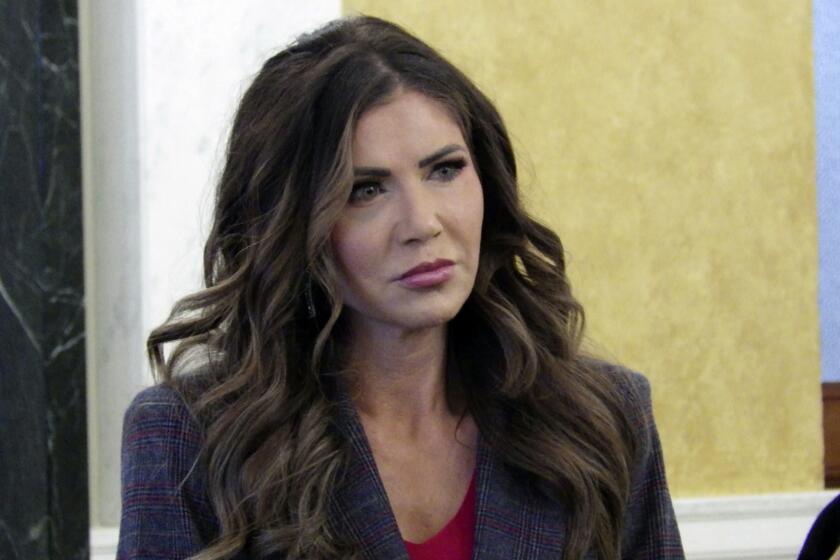John L. Scott, L.A. County’s new sheriff, and his to-do list

L.A. County’s new interim sheriff is John L. Scott, who’s been brought back by the L.A. County Board of Supervisors to try to mend problems with accountability in the wake of federal indictments of 20 deputies and questions over hiring practices.
I overheard this outside the L.A. County sheriff’s headquarters in Monterey Park. “So, how’s he doing?”
“He seems good so far. Everybody’s just wait and see.”
“He” is the interim sheriff, John L. Scott, chosen to replace Lee Baca, who retired as federal indictments were filed on 20 past and present deputies. “He” takes charge of a department widely seen as beset by a see-no-evil culture and favoritism in some of its upper reaches. Scott, who was an L.A. deputy for 36 years, is an insider, an outsider and a short-timer. Here’s his to-do list.
Are more indictments coming?
I’ve asked for a meeting with the federal prosecutor to see whether I can find out.
You have at most 10 months before a new, elected sheriff comes in. What problems need fixing, and why did the Board of Supervisors believe you were the man to do it?
They were looking for an individual who was not going to run for the position, and I had the unique perspective of working both L.A. and Orange County with [some] similar issues: problems in the jail and badges [issued to politicians or supporters].
The image has been tarnished. Things were done that are being investigated that certainly we’re accountable for, but the vast majority of deputies are doing a very professional job.
One of my goals is to restore an image but also the confidence of our public. Then we have accountability. Some things that were in place when I left, I want to restore.
We had SCIF, Sheriff’s Critical Incident Forum, a quarterly look at all the different factors that go into an operation. We determined if there were spikes or trends, and we analyzed why is this high or why is this low. It’s good to take metrics and analyze them and take good ideas and apply them across the board.
Of the 60 reforms recommended by the Citizens’ Commission on Jail Violence, how many have been done?
Close to 50.
So the hard parts are left?
It’s hard in terms of financing. We have to find funding for some of the last components. Policy change and supervisorial monitoring are things we can do pretty quickly, but when you talk about a culture that exists, that takes more than a couple of years. But that doesn’t mean you can’t start.
And you’ve been brought in to do the hard stuff and deliver bad news?
I’ve done it before and I’m willing to do it again, because it’s the right thing to do.
We may elect a sheriff in June, or there may be a runoff in November. How can you work with that timing uncertainty?
My game plan is to push as much through as I can in 10 months. I feel it’s highly unlikely that there’s going to be a clear [winner] in June. I’m looking at this as a 10-month program, but I’m concentrating heavily on the first four months. I’ll [also] be reaching out to each of the candidates about their own plans and goals as we move forward.
In California, elected sheriffs are a constitutional requirement. But should it be an elected or an appointed job?
I truly think that it should be an elected position. That allows for independence within the county workforce.
There is that one element that is concerning when you campaign: Are they expecting something in return? Most people expect [you just to be ] a good sheriff, but there are a few, as in any campaign, looking for a little more.
When you retired from the L.A. Sheriff’s Department in 2005, you didn’t agree with the way some things were being done.
Part of it was some people; I thought they were stepping away from some traditional values. And some processes that I just described were being set aside.
You mean accountability?
Yes, and to me, that opens the door to individual discretion and, in some cases, as we found at the jail, some abuse. And that’s something that I didn’t want to see. I spoke with Sheriff Baca [in 2005], and of course it’s his prerogative on the selections he made, as it is mine today. I think Sheriff Baca is a good man with a good heart and was looking to put what he considered the best people in place. But I don’t think that all those individuals necessarily were following the path that he was taking.
Was he ill-served by them?
Yes, and I think he’d recognize that today.
At your news conference, you spoke of wrong directions, of inaction and neglect. Where did that show?
If your focus is exclusively on one area, you’re going to be missing things in another area, and I think Sheriff Baca had a tremendous focus about the community and the jail programs, but this is such a large department, he left it to his executive staff to handle [other areas]. I will be putting everybody on the same page. If they’re fragmented, just dealing with their own little areas, it’s not teamwork.
How much of the jails’ problems is structural and how much is personnel?
The way it’s designed has a definite bearing on how you supervise. Central Jail is an old linear style; the more open [style] is better — that way you can see things going on. The [linear] design calls for greater physical presence; you have to be walking the floor with more frequency. In the open [style], you can see things more readily. These individuals in jail, we have a responsibility for their safety and security.
Why wasn’t that happening?
There was a point where a large number of inmates were concentrated in an area designed for a much smaller population. Then there’s usually a certain amount of complacency; ultimately, if it’s unchecked, if you don’t have the proper supervision and balances, you can end up with abuse. [In Orange County,] they thought the jails would manage themselves to a certain extent. [Deputies watched TV while inmates ran amok.]
How do you fix that?
I haven’t made any personnel changes per se. I’ve talked with assistant sheriffs and am working my way down to the chiefs for recommendations for change.
In the LAPD, new officers begin on patrol. In the Sheriff’s Department, they start in the jail. Is that a better assignment for a rookie?
I’m a big proponent of starting newly trained deputies at the jail. That provides a foundation. You learn a great deal in jail because you’re working with the very people you’ll be assigned to handle on the street.
The problem is when there’s not enough training in the jail about how that relates to patrol, and there’s not enough change within the jail [for] continuing freshness in their duties.
I’d like to see them moved around a little bit more, and moved out earlier.
What are you hearing from rank-and-file deputies?
I’ve received literally hundreds of text messages, emails and phone calls. I have a real sense that they’re hungry for a fresh approach.
Sheriff Baca had a number of advisory boards; are you changing those?
No, but I’m being very careful not to spend too much time with any one group. I only have 10 months, and my focus is on the internal issues that have plagued the department that I want to correct.
Did the Board of Supervisors tell you what it wants done?
Nothing specific, other than to ensure I’m not a place-holder, that I’m going to take action. The jails are important, but they want to make sure the department is operating the way it was designed and make sure we receive less criticism. Image, but also performance.
What I’m doing right now [is] riding a cyclone. All that I’m trying to do is doable — the question is, 10 months? It’s daunting but rewarding.
How have so many more women and minority deputies changed the department?
It makes it better. L.A. County is very diverse, and the department should represent the population we serve. The Bouman case [a 1980 federal civil rights class-action lawsuit] involving female promotions and assignments [means] today I think we have a pretty good mix. I was involved in 1972 in the “lady deputy patrol program.” [Before], we had women working at the desk, in juvenile and [as] matrons at the jail.
My partner had a skirt, a handbag with her weapon in it and high heels. I remember going on foot pursuit one night and I had to jump over a chain-link fence. I turned around to see what my partner was doing — she had kicked off her heels and hiked up her skirt and over she went. She was not going to let that keep her from doing the job. [After the 1972 program], women were allowed to work patrol. Those 12 set the standard; they were exceptional women.
After we elect a new sheriff, you’ll go back to your old job in Orange County. So the big question: Dodgers cap or Angels cap?
I grew up with the Dodgers, I go back to the Don Drysdale era. I lived in L.A. County until I was married and moved to Orange County. The Angels are closer to home, it’s easier to get to the games, so I’ve got to go with: I’m a fan of both.
This interview has been edited and excerpted from a taped transcript. patt.morrison@latimes.com. Twitter: @pattmlatimes
More to Read
A cure for the common opinion
Get thought-provoking perspectives with our weekly newsletter.
You may occasionally receive promotional content from the Los Angeles Times.







